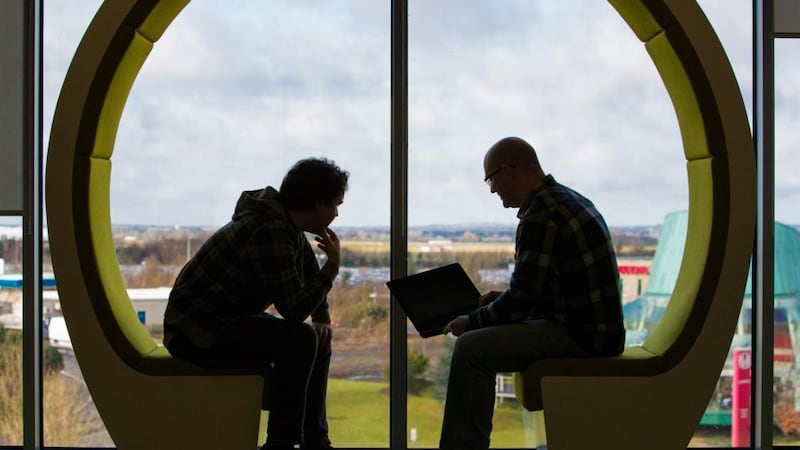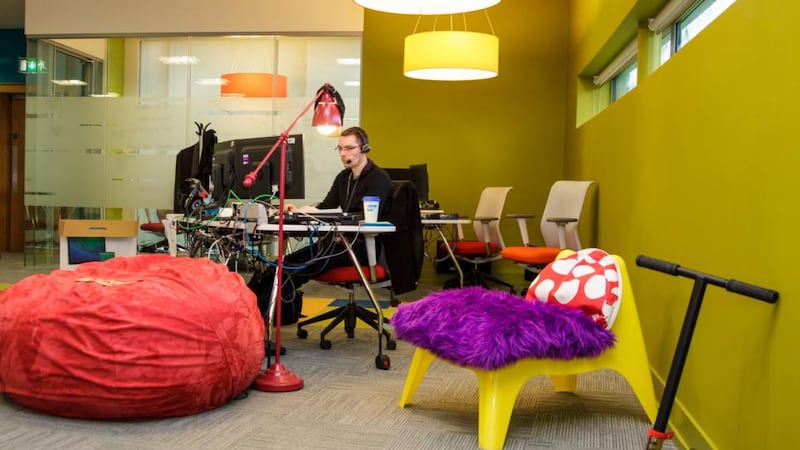There’s an office in Dublin where everything is mobile. Staff can move their desks to a sunnier part of the floor whenever they feel like it. Sofas and screens can be wheeled into impromptu meetings. The only partitions are adjustable whiteboards, and if someone runs out of writing space they can draw on the windows.
This is SAP’s App Haus, a software corporation in Citywest that offers its developers a completely flexible space. “It’s all about instilling this mindset that nothing is really stationary,” says managing director Liam Ryan.
"The inspiration came from one of our founders, who read an article in Forbes on Design Thinking [a problem-solving approach with origins in product design]. We were transforming as an organisation and we needed to shift the way we develop products, so it was more like an intellectual renewal that was being pushed within the organisation. The workspace is just one element of that."


Other elements include using toys and games to spark creativity, taking a flexible approach to time management and building lo-fi prototypes to address challenges. You can see signs of these processes scattered throughout the office: a box overflowing with Lego blocks and pipe cleaners; sprawling diagrams dotted with magnets and pins; there’s even a spot to practise golf putting.
"We also have a 'cool wall' feature, which is copied from Top Gear," says Cristover Lopes, one of the developers. "Every two weeks, we do informal presentations to each other about emerging technologies that we've come across and then we rate them. That enables us to bring ideas in from the ground up that will have an impact on the company."
Evidence that workplace design boosts employee engagement has led some of the world’s most successful organisations to experiment with these kind of practices. Spotify’s offices, for example, are shaped in an oval to promote chance encounters and increased collaboration. Daniel Ek, the company’s CEO, doesn’t even have a desk.
In Ireland, the presence of tech giants has not only redefined our expectations of modern office environments, but forced other sectors to keep up in order to attract and retain talent. Businesses are beginning to take a more considered approach than simply putting everyone in an open-plan office and hoping for the best.
“I think it’s important that we’re challenging what people conventionally perceive as a nice office and try to introduce new ideas, technologies and ways of looking at things,” says Brian O’Neill, director at Cantrell & Crowley Architects and Interior Designers, based in Blackrock, Co Dublin.
‘Much more casual’
“If you look at the likes of Google and Facebook, their way of doing business and their approach to staff is far different to what we would have traditionally seen with, say, the banks or places like that. It’s much more casual and the employees can tell that their welfare is valued. There are studies showing that these approaches create a far more productive environment than the old-fashioned ones, so people are looking at that now and becoming more open to it.
"It's our job to design what you see but also, more importantly, what you don't see. That why you have to develop the brief with the client and ask the right questions before you get to the final brief."
Though every design is unique and tailored to a specific organisation, O’Neill says there are underlying principles in creating an optimal workspace. Among them are giving employees a sense of control over their environment, access to daylight and less reliance on mechanical ventilation.
“I think what you’ve definitely got to avoid is a cattle-market approach where you just have vast open-plans with regimented desks and no individuality. You have to break it down into parts: grouping different departments together but with breakout spaces where even just the colour of the carpet and furniture is changed. Some organisations will have a much greater emphasis on privacy and acoustics, but for others that might not be important, so there are lot of different things to be considered for any one workplace.”
Apart from those underlying principles, one has to factor in questions such as what kind of people will be occupying this office space? What does their line of work require? What is the predominant national culture?
Pulling the answers together is like cooking a complex stew, says environmental psychologist Dr Sally Augustin, head of consultancy Design with Science and author of Place Advantage: Applied Psychology for Interior Architecture.
“You want to build in flexibility,” says Augustin. “Some people expect to spend more time alone; others like to take charge of their environment and do things like move the furniture around. If you don’t plan for that, the space can look ugly pretty fast.”
Influence of colour
Then there are universal psychological considerations. One is the influence of colour: seeing red seems to harm our analytical performance whereas when we’re around shades of green, we tend to think more creatively.
Another factor is that if we’re doing work that requires focus and concentration, we need to be surrounded by a less stimulating environment (and vice versa). This is particularly pertinent when considering the balance of extroverts and introverts, who tend to process stimuli in markedly different ways. Miscalculating those needs can lead to constant distraction and personality clashes.
Similarly, introducing recreational perks like massage services can easily backfire. No amount of bean bags or foosball tables will improve a workplace unless they make a meaningful contribution to an organisation’s culture.
“Research indicates that if you’re trying to create a workplace that’s fun that can be really difficult because almost everyone’s perception of fun is different,” says Augustin. “You’re much better off creating a workspace that provides people with opportunities to mentally refresh after they’ve been doing cognitive work.”
Augustin compares designing a balanced work environment to finding a present for somebody: you have to know them pretty well in order to get it right. Often when a client has seen a television segment or an article about a certain office environment that’s popular, she says, they naturally try to emulate others. But this is a mistake.
“Just because other people are doing it doesn’t mean it’s appropriate for a particular site. That’s why the designer has a responsibility to really listen and, if necessary, stand up to the client. We do our best work in the spaces that show who we are, tell the story of our workgroup and have certain types of support in place. It’s in everyone’s interest to get that right.”











